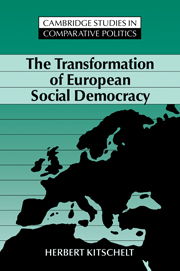Book contents
- Frontmatter
- Contents
- List of tables and figures
- Preface
- Glossary of political parties by country
- Introduction
- 1 Social structure and collective preference formation: Opportunities for left party strategy in the 1970s and 1980s
- 2 Class structure and left party performance
- 3 Political economy and left party fortunes
- 4 Social democratic strategy and electoral competition
- 5 Internal politics in socialist parties: Preference formation, aggregation, and strategic choice
- 6 The socialist discourse: Political semantics and party strategy
- 7 Social democracy in decline? Analytical and normative extensions of the argument
- References
- Index
2 - Class structure and left party performance
Published online by Cambridge University Press: 08 January 2010
- Frontmatter
- Contents
- List of tables and figures
- Preface
- Glossary of political parties by country
- Introduction
- 1 Social structure and collective preference formation: Opportunities for left party strategy in the 1970s and 1980s
- 2 Class structure and left party performance
- 3 Political economy and left party fortunes
- 4 Social democratic strategy and electoral competition
- 5 Internal politics in socialist parties: Preference formation, aggregation, and strategic choice
- 6 The socialist discourse: Political semantics and party strategy
- 7 Social democracy in decline? Analytical and normative extensions of the argument
- References
- Index
Summary
In the previous chapter I proposed a new account of voter preference formation based on citizens' market and organizational experiences in the production sector and age or life cycle, gender, and experiences in the reproduction sector rather than on economic class. Moreover, parties' fortunes are not bound to particular socio-economic groups, but depend on parties' strategic choices in the arenas of interparty competition and intraparty decision making. Because this complex, non–classbased argument about voter alignments and party competition goes against the grain of much work in this area, in this chapter I examine the limitations that traditional class structural approaches building on stratification research and Marxist class theory encounter when they attempt to explain social democratic party fortunes in the 1970s and 1980s. Class approaches are more parsimonious than my own theoretical account. Yet my analysis in this chapter shows that any effort to remedy the theoretical and empirical flaws of class-based accounts of party fortunes calls for consideration of those popular political demands and those attributes and forces internal to the field of political competition I have proposed. The constructive purpose of this chapter on class theory is to illustrate the transformation of social structure in contemporary democracies and the ability of many social democratic parties to transcend a narrow working-class base. Social democrats do not face a simple “trade-off” between working-class and non–working-class support, but a considerable range of choices to assemble electoral coalitions.
I first examine a naive theory of class politics that contends socialist parties weaken in direct correspondence to the contraction of the blue collar industrial working class in advanced capitalism.
- Type
- Chapter
- Information
- The Transformation of European Social Democracy , pp. 40 - 66Publisher: Cambridge University PressPrint publication year: 1994

